Topic: Management
No matches on dating apps? It’s a you problem
Is ‘kind productivity’ the future of work?
Phil Graves is the new CFO of Meati Foods
Research reveals the key to an irresistible online dating profile
 In writing a good online dating profile, the average love-seeker is likely to fill it up with all the appealing qualities and interests that make them special. They paraglide and do hot yoga on the weekends; enjoy Riesling on the beach or seeing indie bands in basements; are a Libra with Scorpio rising; or have a dog or three kids or an iguana. There’s one thing they routinely leave out, however: what they want to know about their potential partner.
In writing a good online dating profile, the average love-seeker is likely to fill it up with all the appealing qualities and interests that make them special. They paraglide and do hot yoga on the weekends; enjoy Riesling on the beach or seeing indie bands in basements; are a Libra with Scorpio rising; or have a dog or three kids or an iguana. There’s one thing they routinely leave out, however: what they want to know about their potential partner.
Yet, that detail might be the most important thing to include, according to research by Haas Associate Professor Juliana Schroeder.
“People want to be known, so they’re looking for partners who will know them and support them,” she says. “But because other people also want to be known, they end up writing these not-super-appealing profiles when trying to attract partners.”
In her recent paper “Feeling Known Predicts Relationship Satisfaction,” Schroeder argues the phenomenon occurs not only with romantic couples, but in all manner of interpersonal relationships, including friends, neighbors, family members, work colleagues, and casual acquaintances. In each case, people were more satisfied when they felt like they were known, rather than when they felt like they knew the other person, according to a series of experiments Schroeder carried out with co-author Ayelet Fishbach of the University of Chicago Booth School of Business.
“Of course, people say they want to know their relationship partner and support their partner,” says Schroeder, Harold Furst Chair in Management Philosophy & Values at Berkeley Haas. “But that’s not actually the thing that makes them happiest in their relationships. People feel happier in relationships where they feel like they are being supported—and for that, they have to be known.”
Hear Schroeder talk about her paper in this short video (full transcript at end of article):
Relationship satisfaction
Fishbach noted that the research project started a decade ago after she and Schroeder discovered that patients want their physicians to not have emotions of their own so that they can fully attend to them and feel their pain—a phenomenon they called the empty vessel effect. “We wondered whether this is a more general phenomenon whereby people are attuned to what others know about them more than what they know about others,” Fishbach says.
In an initial set of experiments, published in the Journal of Experimental Social Psychology, the researchers asked participants to rate how well they believed they knew a family member, partner, or friend, compared to how well they believed they were known—and then to rate their relationship satisfaction on a scale of 1 to 7. Interestingly, people routinely thought they knew the other person better than the other person knew them. This effect has been called the illusion of asymmetric insight. “People think they are unique and special and have a lot of complexity to them, so other people just don’t know their true self,” Schroeder says. “Whereas once they know one thing about the other person, they’re like ‘I know you. Done.’”
Perhaps because it’s so rare to feel that anyone really knows us, people value it more highly in their relationships. In fact, the degree to which they knew the other person mattered less in how they felt about the relationship compared to the degree to which they felt they were known, regardless of how they felt about the overall quality of the relationship.
In another study, the researchers presented participants with one of two scenarios in which they ran into an acquaintance at a party who either forgot their name or whose name they forgot. Participants had different reactions to the two scenarios – as Schroeder summarizes: “If you forget their name, it’s not great for the relationship, but if they forget your name, it’s much worse — the relationship is over,” Schroeder says.
What’s missing from online dating profiles
Carrying these concepts over to dating profiles, Schroeder and Fishbach enlisted a team of research assistants to examine profiles from dating sites Match.com and Coffee Meets Bagel. Based on statements in the profiles, they rated more than 50% of the writers as wanting to be known by a potential partner, while only about 20% expressed a desire to know their potential partner.
They then asked several dozen online participants to write their own profiles, either emphasizing being known or getting to know the other person. Finally, they asked more than 250 other people to rate these profiles on a scale of 1 to 7, according to how much they found them appealing and how much they would potentially want to contact them. In keeping with the rest of their findings, Schroeder and Fishbach found that the raters preferred those profile-writers who emphasized wanting to know the other person.
Those findings could be instructive for someone trying to make themselves as appealing as possible on a dating site. “What they want to be doing is saying, ‘I really care about you, and I’m going to get to know you and be there for you and listen to you and be a great partner,” Schroeder says.
In all of the studies, there was only one type of relationship in which people did not care about being known: a parent’s relationship with their child. “In fact, we found an effect going in the opposite direction,” Schroeder says. “The thing that predicts relationship satisfaction is not how well they think their child knows them, it’s how well they know their child.” That makes sense, she adds, lending credence to the idea that the phenomenon is essentially about support. “It’s the one relationship where it’s very clear the parent needs to be supporting the child.”
The next step for Schroeder and Fishbach is to consider how people might shift their focus towards using their knowledge of other people to make them feel known in a genuine way. In a workplace context, for example, it’s possible that feeling known might not only improve relationship satisfaction with colleagues, but overall job satisfaction as well. “To develop relationships with work colleagues, you might think not just about personal knowledge, but also what are people’s habits and how they like to work,” Schoeder says. “While this was beyond the scope of our study, it’s possible that stronger workplace relationships could ultimately make a difference in terms of people’s satisfaction with their jobs.”
Read the full paper:
Feeling known predicts relationship satisfaction
By Juliana Schroeder and Ayelet Fishbach
Journal of Experimental Psychology, March 2024
Video Transcript
Hi, I’m Juliana Schroeder.
I am a professor in the Haas School of Business in the Management of Organizations Group. And I study social psychology and social connection and how people are most effective in being able to form relationships with others.
[Question on screen] What makes people feel satisfied in their relationships?
I recently wrote a paper that investigates what are the components of what makes people satisfied in their relationships.
And in particular, we were looking at relationship knowledge, subjective relationship knowledge, how well I think the other person knows me and how well I think I know the other person. Both of those things have been found in prior research to be good for your relationship: The more I feel like the other person knows me and the more that I think I know the other person, the greater is my satisfaction in the relationship, the better I feel about the relationship.
But it turns out that one of those things matters a lot more for my relationship satisfaction.
And the thing that matters more is how well I feel that the other person knows me. That matters on average across all the different relationships that we look at about twice as much as compared to how well I think I know the other person.
[Question on screen] How did you test that?
So here is one example that we tested in one of our experiments. We had people imagine knowing or not knowing different things about someone that they had recently met.
And so to give you one of the scenarios we used, we asked people to imagine that they forgot an acquaintance’s name. So they didn’t know that about the person or they forgot a detail of their childhood—that was another scenario we examined in a different experimental condition. We told them what if the other person forgot your name or forgot a detail about your childhood? How bad would that be for the relationship?
And what we found was that if they imagine the other person forgetting something about them, they think of it as being much worse for the relationship then if they imagine forgetting something about the other person.
[Question on screen] How does this apply to dating?
It may seem obvious that feeling known is good for your relationship and your relationship satisfaction. But we have some preliminary evidence that suggests that people don’t necessarily realize this or don’t take it into account enough in their relationships.
In one study, we looked at online dating as a context and we went to common online dating websites like match.com, we went to Coffee Meets Bagel and we looked at the profiles that people wrote on those different websites.
And what we found is that in almost every profile, people would say something that is relevant to their wanting to be known. So they might say, like I’m looking for someone who will listen to me or support me and they’ll write something that relates to that.
But very rarely would people signal the opposite—hat I am looking for someone that I can listen to and that I can support and that I can get to know.
And that was interesting because in fact, when we ran an experiment on this, the people that signal that they are looking for partners who they want to know and support and care about—that, of course, is much more appealing to potential partners than the opposite.
And so, people are maybe using the wrong strategy in writing their dating profiles if they really want to be optimally attractive to as many partners as possible.
Women of the c-suite: Swati Reichmuth of Rune Labs on the five things you need to succeed as a senior executive
Gen AI, hybrid work, and DEIB are hot topics at 6th annual Culture Connect Conference
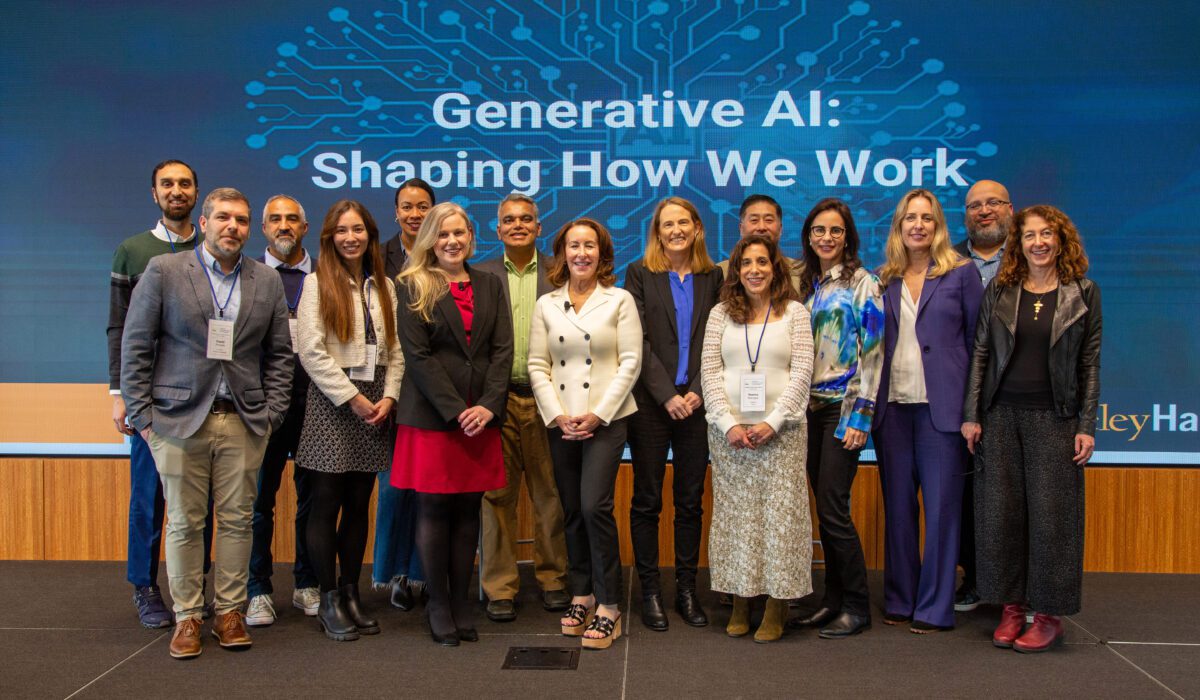
More than 250 business leaders and academic researchers gathered at Berkeley Haas from Jan. 9-10 for the sold-out Culture Connect Conference, sharing challenges and insights on creating high-performing, inclusive cultures in the age of generative AI and hybrid work.
The sixth annual conference, organized by the Berkeley Haas Center for Workplace Culture and Innovation (BCC), featured talks by top leaders from IBM, Lyft, Pixar, LinkedIn, Hubspot, and other leading companies, along with hands-on workshops and discussions. It was led by the center’s Co-Founding Directors Jennifer Chatman and Sameer Srivastava, and organized by Program Director Audrey Jones.
Chatman, the Paul J. Cortese Distinguished Professor of Management at Haas, said she was struck by the stories leaders shared of trying, failing, and trying again as they have experimented in real time with AI and hybrid work.
“My biggest takeaway is that an experimental mindset is critical as organizations approach these very significant changes that everyone is facing today,” Chatman said. “Organizations are going through seismic shifts in how they are thinking about and conducting work. The conference was fascinating because leaders shared their stories—the good and the bad—as they navigate these changes.”
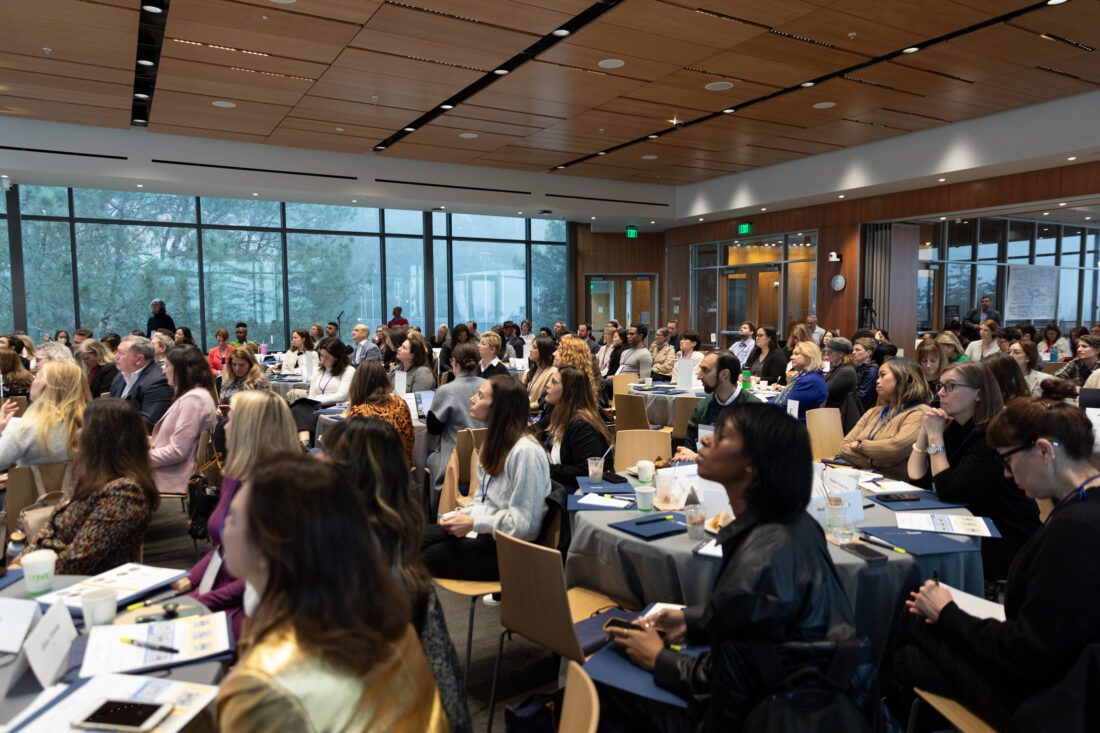
This was the first year the conference was open to the broader public beyond invited presenters and BCC partners. Attendees included about 100 academics and 150 industry leaders from a diverse range of industries, including health care, biopharmaceuticals, media, tech, financial services, film, government, and nonprofits. Seventy companies represented.
“The combination of research-backed evidence from academics and practical advice from seasoned industry leaders is difficult to bring together but when it happens, it yields a level of insight that could not be achieved by either perspective alone,” added Srivastava, the Ewald T. Grether Professor of Business Administration and Public Policy. “We’re immensely grateful to every speaker, workshop leader, facilitator, and participant who contributed to making this a meaningful event of learning and connecting.”
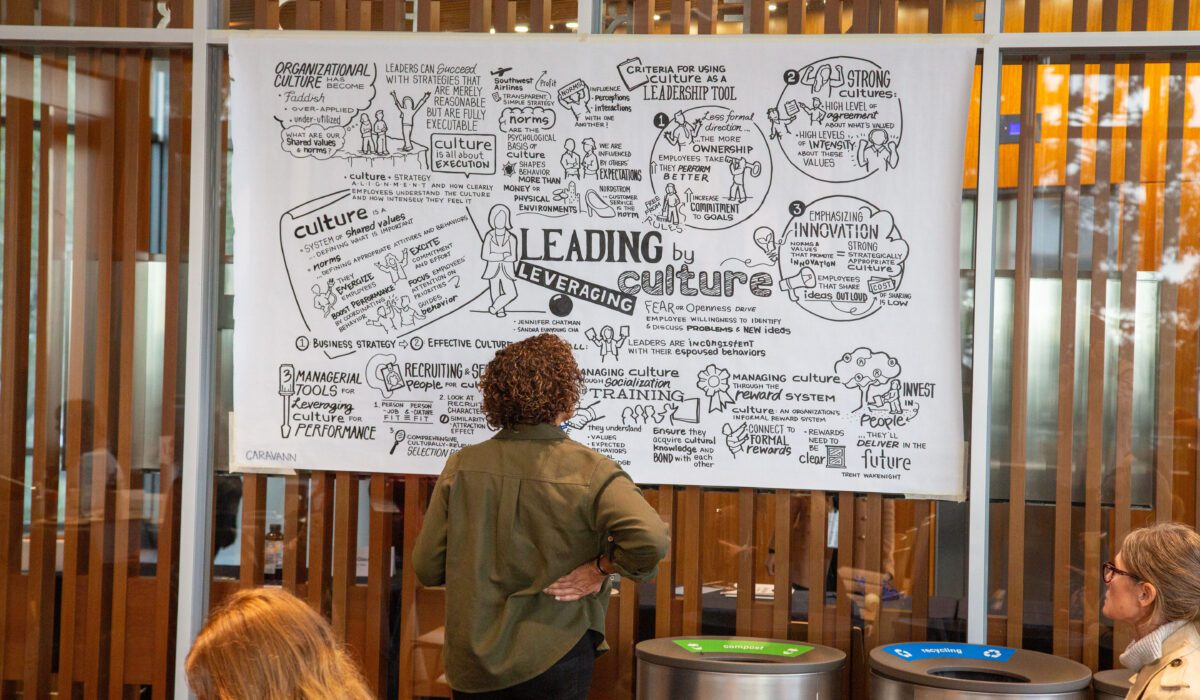
Day 1: Diverse perspectives on organizational culture academic research
The first day of the conference emphasized research, with presentations from 34 scholars from around the world who examine culture through the lens of sociology, social psychology, and economics. Keynote talks included Paul Ingram of Columbia on how people tend to conceal social class identities; Doug Guilbeault of Berkeley Haas on how gender biases tend to be stronger and more persistent in online images than in text; Anita Williams Woolley of Carnegie Mellon on how the drivers of collective intelligence in teams differ from individual intelligence; and Leo Bursztyn of the University of Chicago on how to create social change by correcting misperceptions about prevailing norms.
Former Haas Dean Rich Lyons, Associate Vice Chancellor and Chief Innovation & Entrepreneurship Officer at UC Berkeley, and Laura Hassner, executive director at UC Berkeley Innovation & Entrepreneurship, reported on the success of the UC Berkeley Changemaker program, a campus-wide certificate program including about 30 courses addressing critical thinking, communication, and collaboration—and enrolling about 20% of undergraduates.
Doctoral student Yingjian Liang of Indiana University Bloomington won the Edgar Schein Best Student Paper Prize. Second place went to Danyang Li of Berkeley Haas.
Day 2: Deep dives into three key themes
Future of work and hybrid workspaces
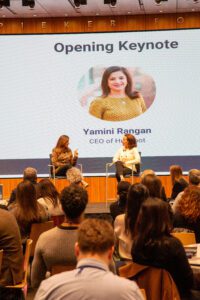
The second day of the conference was attended by about 200 industry leaders and academics. HubSpot CEO Yamini Rangan, MBA 03 (left), sat down with Chatman (right) for a fireside chat. Rangan said companies should treat culture as a product that management consistently refine. “You have to evolve your culture every day, every week, like a product,” Rangan said. She also emphasized the importance of building a team of leaders, rather than building a leadership team to make culture inclusive. “Culture is how people behave when leadership is absent,” she said.
Nicholas Bloom, an economics professor at Stanford, shared data on how firms are adapting to remote and hybrid work across different sectors of the economy. Bloom noted that the effect of remote work on productivity has been neutral, while the impact on productivity has been typically positive. “Organized hybrid has won,” he said.
Kristen Sverchek, president of Lyft, detailed the company’s journey with hybrid work, and Martine Haas, a management professor at the Wharton School, offered a framework for thinking about a firm’s hybrid culture.
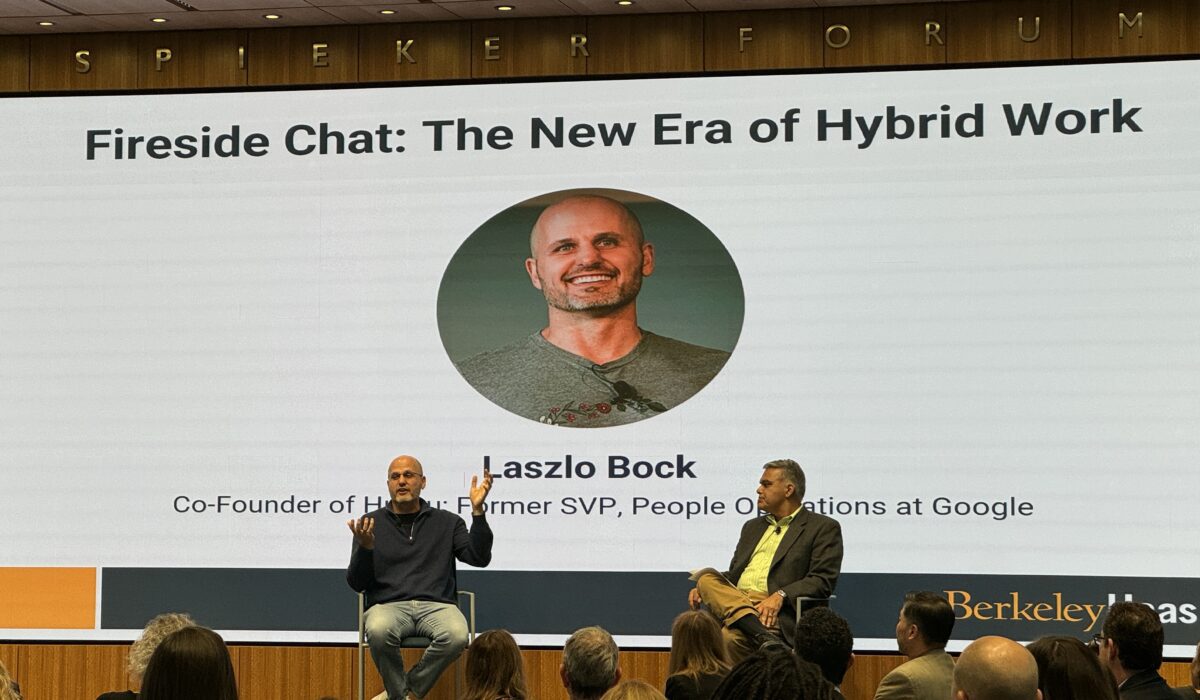
In a fireside chat with Srivastava (above right), Laszlo Bock, CEO and co-founder of Humu & Gretel.ai (above left), discussed how to help employees find meaning and connection while using hybrid work models. Bock, who formerly worked in People Operations at Google, shared an impactful exercise used at Google: Find three or four interesting stories about people within the company, and brief execs on these stories again and again so that they retell the stories. These stories aren’t PR, he said—they will resonate to help give a sense of a strong, cohesive culture.
DEIB focus
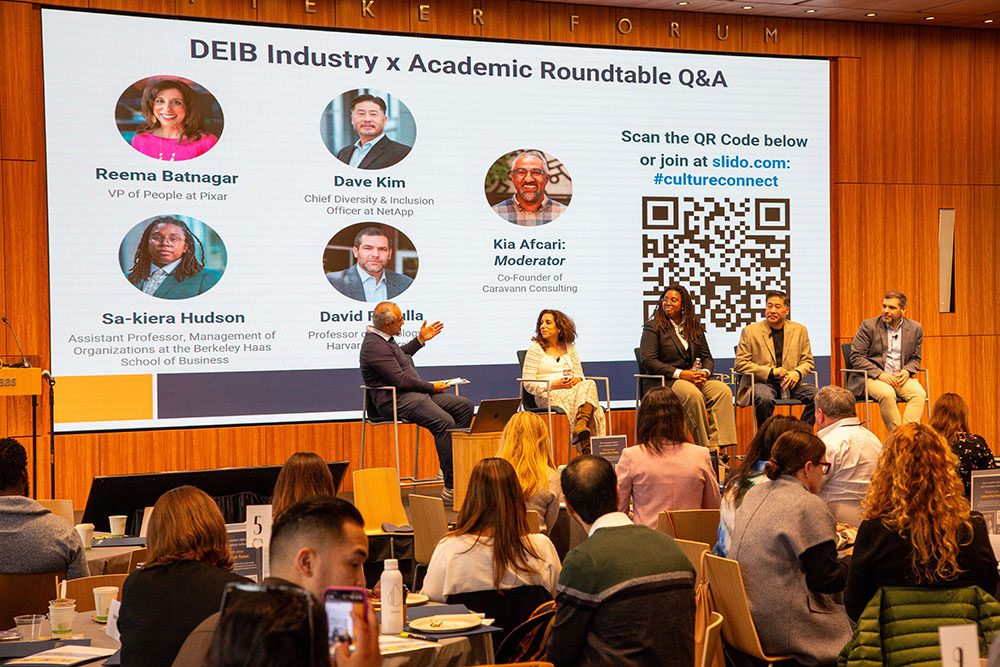
Shifting focus, Co-founder, Coach, and Consultant Kia Afcari (above left) moderated a roundtable on diversity, equity, inclusion, and belonging.
During the discussion, Reema Batnagar, vice president of people at Pixar (2nd from left), emphasized the importance of using personal stories as a way to foster inclusion and belonging at work. David W. Kim, chief DEI officer at NetApp (2nd from right), discussed why corporate leaders must maintain the momentum of their DEI efforts despite recent pushbacks. David Pedulla, a sociology professor at Harvard (right), highlighted the extent to which various forms of discrimination still persist in the labor market.
Sa-kiera Hudson, an assistant professor at Haas (middle), shared recent research findings that emphasize the importance of understanding intersectionality, specifically how gender and race can work together to amplify or dampen various forms of bias. Hudson emphasized that people are complex and we should never assume that their experience within a group is aligned with their perceived identity.
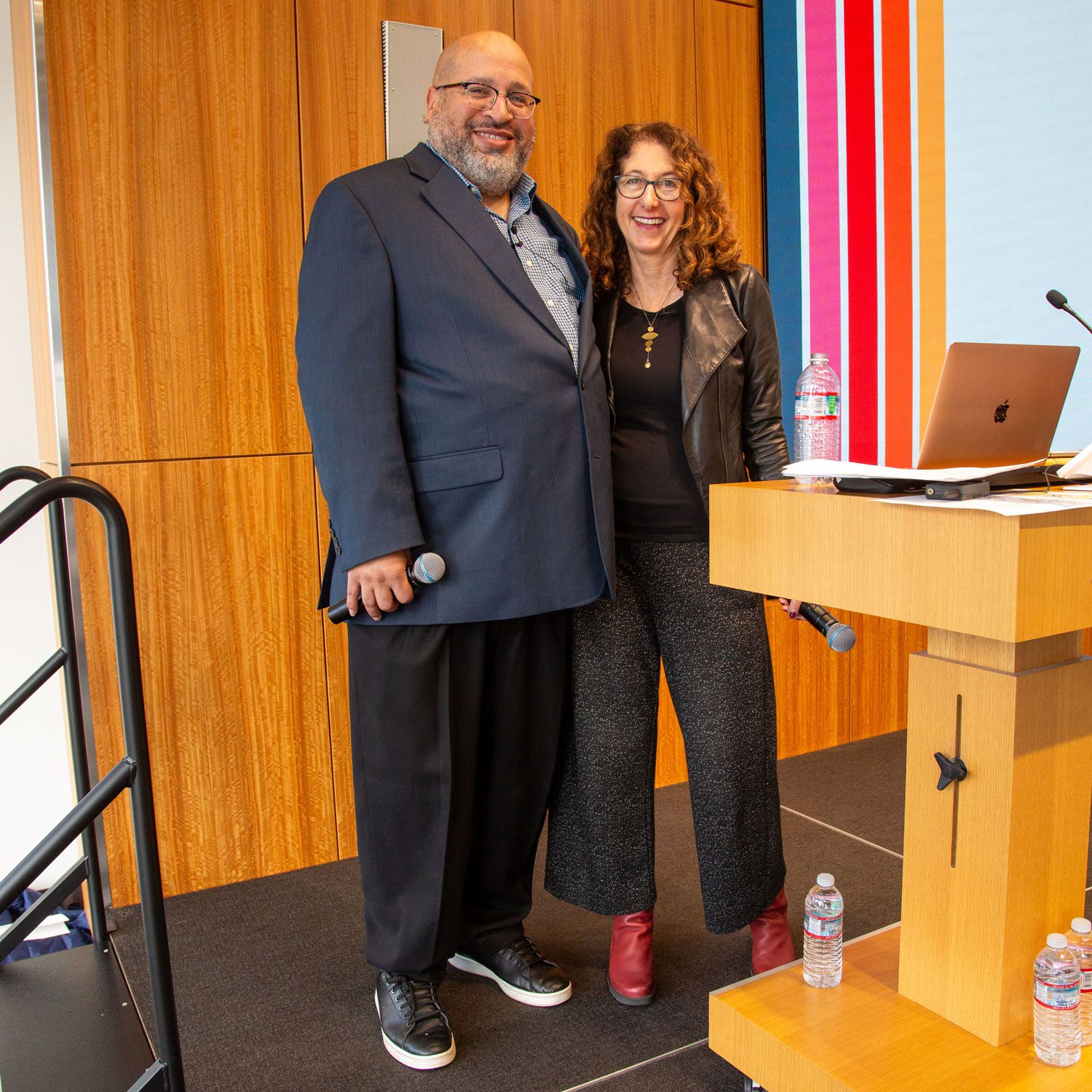
CreativityPartners Chief Associate Chris Bell (above left) and Co-founder and CEO Jamie Woolf (above right) led a workshop on how to create a sense of belonging through mutual storytelling.
Generative AI’s transformative role
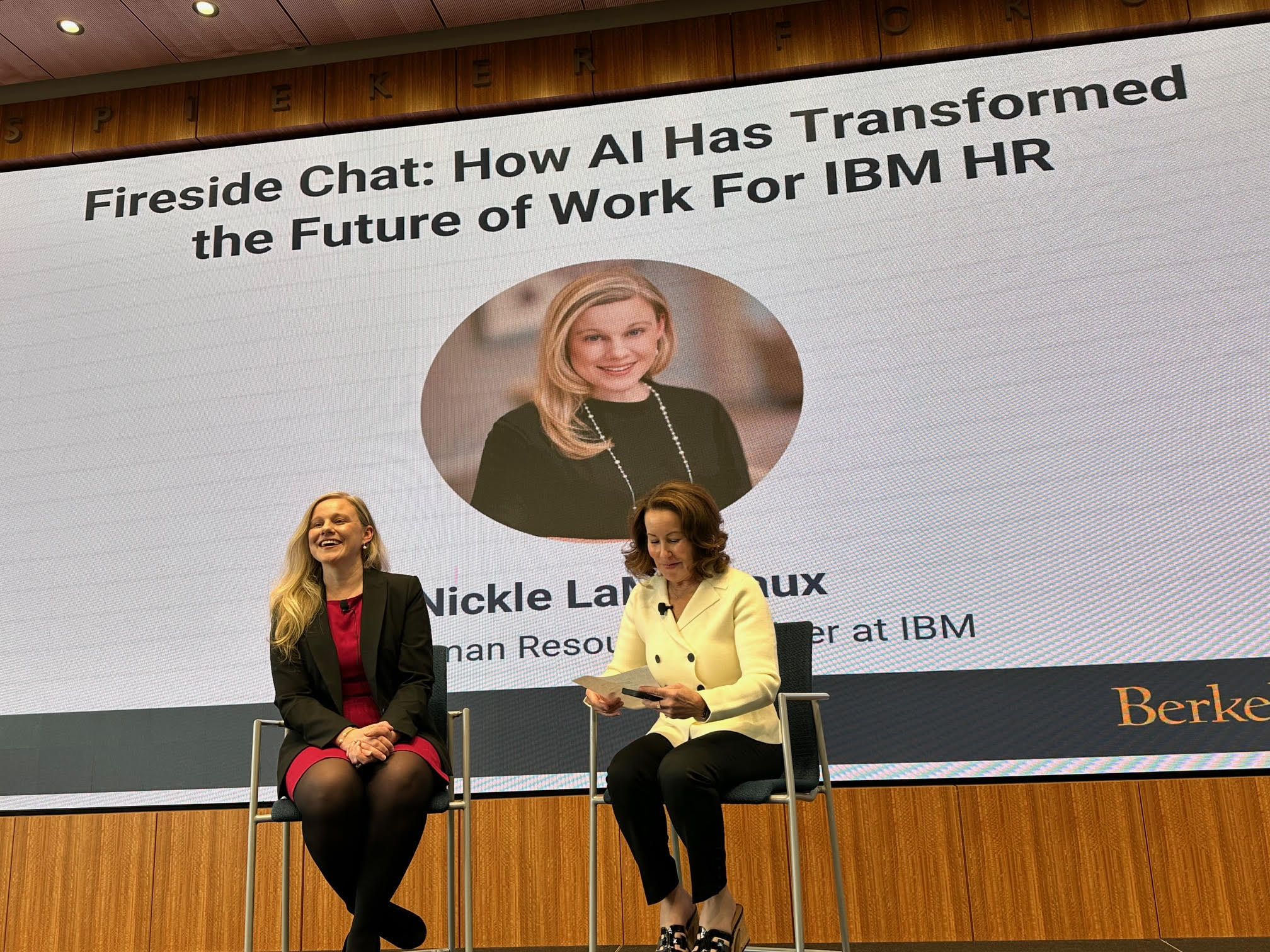
In a fireside chat with Chatman (above right), Nickle LaMoreaux, chief human resources officer at IBM (above left), described how she and her colleagues have been harnessing AI to transform the role of HR in the organization.
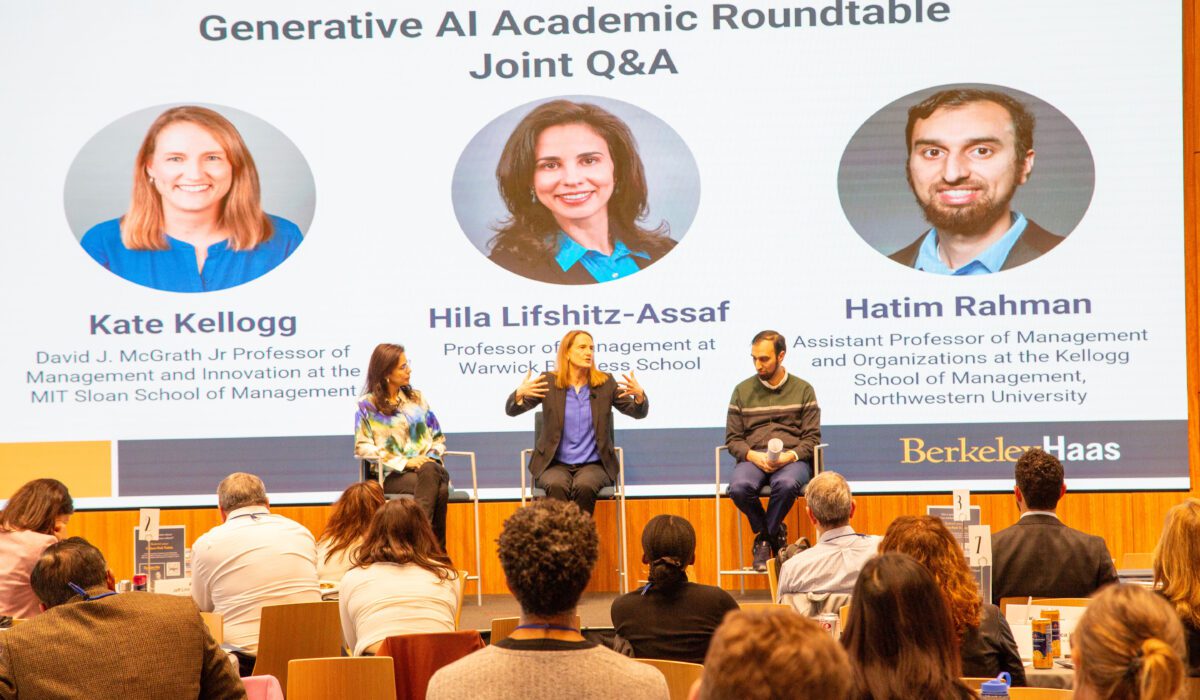
MIT Professor Kate Kellogg (above middle) and Warwick Business School Professor Hila Lifschitz-Assaf (aboove left) discussed a generative AI field experiment conducted at Boston Consulting Group. Hatim Rahman (above right), an assistant professor at the Kellogg School of Management, shared research on the importance of technological certification in the labor market.
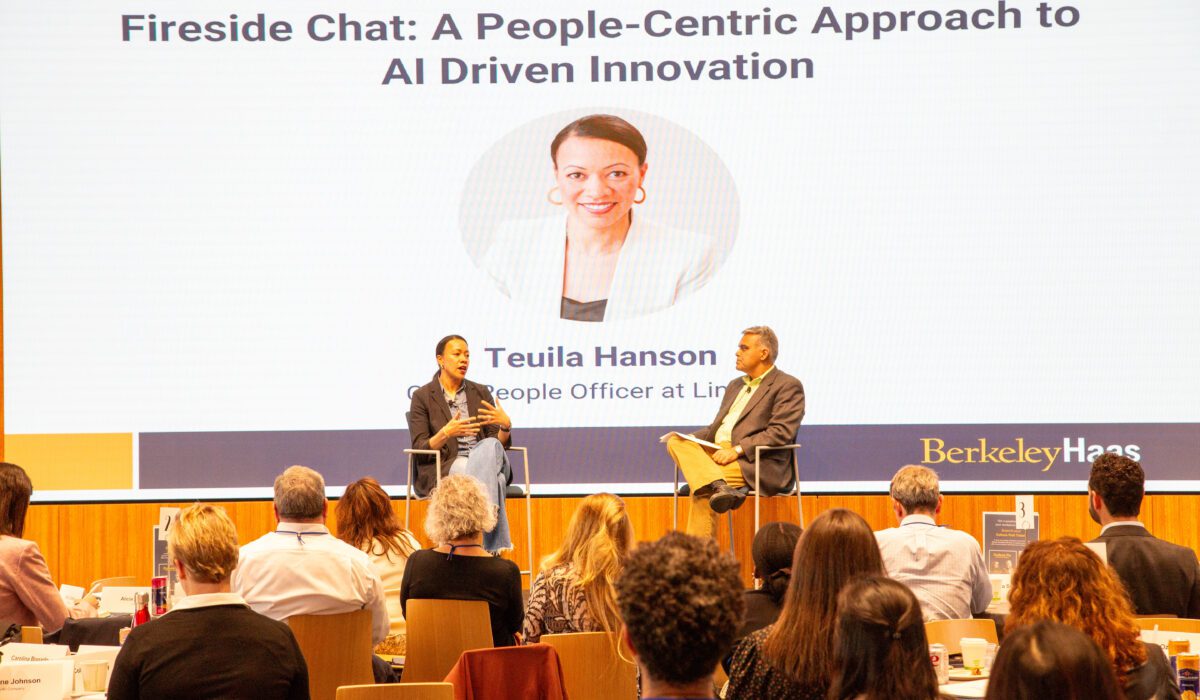
Teuila Hanson (above left), chief people officer at LinkedIn, emphasized the need to take a people-centric approach when adopting AI tools and technologies, since human skills—including human intuition that AIs lack—are critical. “The future of work is still human,” she said.
Former CEO of Athleta to lead Levi’s Beyond Yoga as co-founder exits
Here’s how to build a global company culture
Feel-good spaces: Study shows how to engage employees in the office

Pre-pandemic, companies sunk millions into office redesigns: cubicles were out, replaced by open, flexible layouts—often with ping pong tables, well-stocked kitchens, or other on-site perks.
Post-pandemic, companies are changing it up again, setting up hot-desking and hoteling spaces for hybrid workers.
But new Berkeley Haas research suggests that leaders wanting to build employee engagement should think less about rearranging the furniture and more about how employees relate to their workplace.
“When people feel a sense of self-esteem and distinctiveness derived from their workspace, we found it enhances their engagement,” says Brandi Pearce, a member of the Haas professional faculty. “It also enhances collaboration and their commitment to the organization.”
Pearce refers to that sense of connection to one’s physical space as “place identity,” a term derived from environmental psychology that is often used to understand how people relate to public spaces or communities. In a paper published in the journal Organizational Dynamics, Pearce and co-authors from Stanford and Pepperdine universities explore the importance of place identity in organizations.
Their findings offer guidance for leaders who want to build employee engagement at a time when the very concept of a workplace has become increasingly fluid.
Connections and belonging
The research team studied a software company transitioning workers at sites throughout the world from traditional offices to open-plan innovation centers—complete with movable furniture and whiteboards, colorful walls, sofas, and beanbag chairs—to promote agile work. Despite the popularity of such open-office plans, academic research on their benefits has been mixed, and Pearce said she was struck by how different people at the company reacted to the new environment.
“For some people, that type of space is amazing—they have access to their leaders and their colleagues at any time,” Pearce says. “And for others it reduces all the signals of their own status inside of the hierarchy. Or it’s impossibly distracting. Or they view it as rough and rugged.”
Whether people accepted or rejected the innovation centers didn’t seem to align with their work functions or professional backgrounds, nor with age, gender, location, or other factors. “We got really curious about that, and started to notice that what seemed to matter more than the space itself was how people felt the space connected to them personally, positively differentiated them and reflected a sense of belonging to something meaningful,” Pearce says.
In observations, interviews, and surveys across two studies at innovation centers in the U.S., China, India, France, and Israel, the researchers found that people who described feeling most connected to the innovation centers also expressed more excitement about their work and the organization overall. “What they described was distinct from other sources of work identity, such as team, professional, and organizational identity. “
In fact, this distinctive sense of place identity was associated with critical work outcomes, their studies showed. “Overall, our data suggest that workers collaborate more actively with one another, are more engaged, and are more committed to the organization when there is more place identity.”
Cultivating place identity
To cultivate place identity, leaders should be just as intentional about setting the social conditions for the workspace as they are about the physical design, Pearce says. Whether the setting is physical, hybrid, or virtual, she suggests three best practices:
- Broadcast the vision of the space. No matter the setup, leaders should clearly communicate the purpose of the space and what kinds of work that will be done in the various workplaces—brainstorming sessions, workshops, and other collaborative tasks onsite, for example, while saving focused time for home offices. Leaders can help define virtual workspaces as well; such as stating whether video conferences are spaces for efficiency or connection.
- Model enthusiasm for how to use the space. While visioning is important, equally critical is the way in which leaders convey a positive attitude about the space. In a hybrid setting, for example, leaders can express enthusiasm by using the various spaces as intended, such as holding in-person meetings on in-office days and visibly blocking calendar time during remote-work days for solitary work.
- Empower employees. The researchers found the highest levels of place identity among the teams that spent the most time envisioning goals for their space, so leaders should involve workers when creating a new space. In established spaces, leaders should encourage workers to adapt the space to suit their work needs or create something together, like a piece of art, that can build identity. Remote workers could be given materials to customize their spaces, or—if they do visit the office—create something with co-workers to bring home.
“Companies invest a lot in their physical spaces, but we see place identity as a fundamental human process that also requires investment,” she says. “The investment that leaders make in understanding and promoting the vision of the workspace, conveying a positive attitude and empowering workers to customize their spaces helps cultivate place identity and may be key to unlocking collaboration, work engagement and organizational commitment—whether near or far or inbetween”
Why connecting is so hard
Top of Her Game
Ann Harrison honored as dean of the year by Poets & Quants
Dean Ann Harrison, a renowned economist lauded for keeping Haas’ six business programs ranked among the world’s best and significantly expanding the breadth and depth of the faculty, has been named Dean of the Year by Poets & Quants. Harrison is the 13th dean and the third woman to receive the honor from the publication, which covers business school education.
Poets & Quants Editor-in-Chief John Byrne announced the news to a global audience at a Thinkers50 virtual conference in October. Byrne engaged in a sweeping conversation with Harrison that covered the impact of globalization on workers, the responsibilities of government and business in fighting climate change, the critical role of diversity on campus, and the enduring importance of the MBA.
Demand for business education is growing, Harrison said, but the expectations of what students get from that education has also changed. “Students care about making a difference through business. They want more than just a great paycheck,” she said. “They really care about the world at large.”
In a Poets & Quants article, Byrne wrote that “Harrison has amassed an unimaginable and nearly breathtaking record of achievement” during her four-and-a-half years as dean. Harrison, who has led Haas since January 2019 and was reappointed to a second term last February, said she was “deeply humbled” by the honor.
“I am so lucky to be surrounded by a tremendous community at Haas—students, staff, faculty, and alumni who are always going beyond themselves,” she said. “It is only together that we can seek solutions to climate change, build a more inclusive society, and fuel innovation in all its forms.”
Big Changes
Since joining Haas from Wharton, Harrison has made significant changes, Byrne noted. She has led a major diversity, equity, inclusion, justice, and belonging (DEIJB) effort, broadening the profile of the Haas faculty, school board, and student body. The school’s entering full-time MBA class this year is 41% women, 47% U.S. minorities, and 13% U.S. underrepresented minorities. Harrison has also woven sustainability content deep into the curriculum while maintaining the school’s historical focus on entrepreneurship and innovation.
“The challenges of climate change permeate all aspects of business: supply chain, economics, management, and finance,” Harrison said. “In the latter field, we have pioneered new ways of investing. We need to hire in all these dimensions. It is a big agenda and we are making a lot of progress in a lot of different ways.”
Harrison also oversaw the launch of the first Flex online MBA cohort at any top business school. Applying learnings from the pandemic, Haas used new technology to make the MBA available to expanded groups of remote students and working parents requiring flexible schedules.
Under Harrison’s leadership, Haas raised a record total of $227 million, including $56.1 million during the last fiscal year. The school also secured the largest single gift in the school’s history—$30 million from alumnus Ned Spieker, BS 66, and his wife, Carol, BA 66 (political science)—to turn the undergraduate program into a four-year program.

Figuring it out together
In the Poets & Quants article, Courtney Chandler, MBA 96, Haas’ chief strategy and operating officer and senior assistant dean, noted that Harrison “hasn’t stayed in one lane as dean.”
“She’s ambitious, and she sees the full potential of Haas within UC Berkeley and is driven to realize that potential,” Chandler said. “She has not been that one-dimensional dean and that is incredibly impressive.”
Harrison’s record as a highly cited scholar has also helped her work with the school’s faculty. Erika Walker, senior assistant dean for instruction, who has been at Haas for nearly 20 years, told Byrne that Harrison has succeeded in securing faculty support for her vision, which isn’t an easy task. “She relates so well to them,” Walker said. “Ann is very thoughtful about where we should be going. A lot of her success stems from her ability to get the buy-in and then enlist others to figure it out together.”
“I am so lucky to be surrounded by a tremendous community at Haas—students, staff, faculty, and alumni who are always going beyond themselves. It is only together that we can seek solutions to climate change, build a more inclusive society, and fuel innovation in all its forms.”
—Dean Ann Harrison
During her second term, beginning in January, Harrison said she’ll work with her team to build upon the school’s academic excellence and to continue enhancing the student experience. One important goal is to ensure that the school’s degree programs remain the best in the world, she said. In its 2023 b-school ranking, the Financial Times named Haas’ full-time MBA program #7 worldwide and among the top four U.S. programs, a record high. U.S. News & World Report ranked the evening & weekend MBA program #1 among part-time MBA programs and our undergraduate program #2. The Financial Engineer ranked Haas’ master of financial engineering program #1 in the world.
“This is a business school that embodies excellence,” Harrison said. “I feel great pride in our past and am thrilled to have the opportunity to create impact for the future.”
Crisis Management
Mastering upheaval and systemic transformations
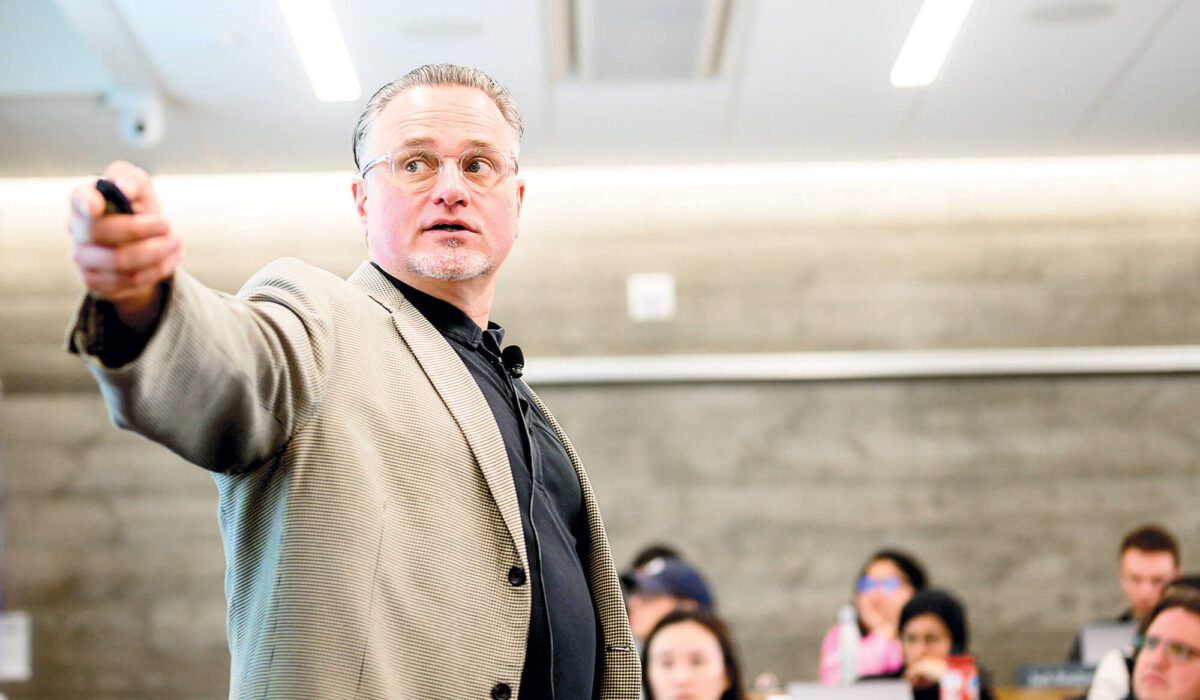 Olaf Groth doesn’t like to make predictions, but he’s nonetheless become adept at helping executives see around corners and navigate the chaos of recent years.
Olaf Groth doesn’t like to make predictions, but he’s nonetheless become adept at helping executives see around corners and navigate the chaos of recent years.
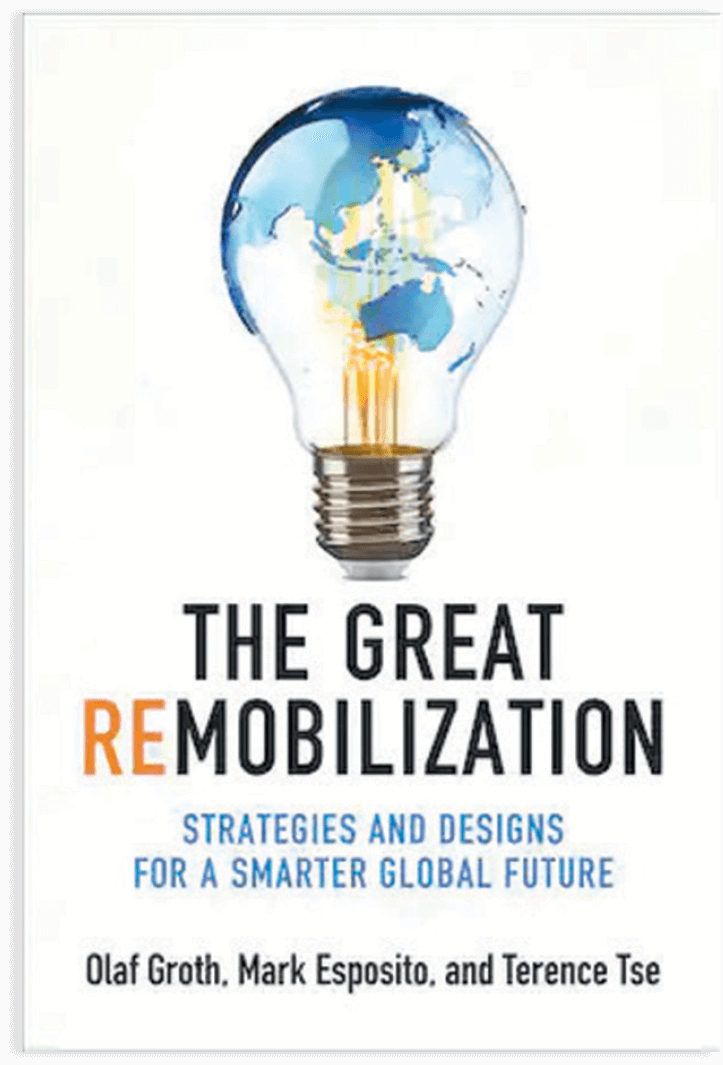 A member of Haas’ professional faculty and a senior adviser at the Institute for Business Innovation, Groth is also chairman and CEO of think tank Cambrian Futures. In a new book, The Great Remobilization: Strategies and Designs for a Smarter World (MIT Press, 2023), he and co-authors Mark Esposito and Terence Tse focus on what they call the Five Cs—COVID; the cognitive economy, crypto, and web3; cybersecurity; climate change; and China—and show leaders how to power human and economic growth by replacing fragile global systems with smarter, more resilient ones.
A member of Haas’ professional faculty and a senior adviser at the Institute for Business Innovation, Groth is also chairman and CEO of think tank Cambrian Futures. In a new book, The Great Remobilization: Strategies and Designs for a Smarter World (MIT Press, 2023), he and co-authors Mark Esposito and Terence Tse focus on what they call the Five Cs—COVID; the cognitive economy, crypto, and web3; cybersecurity; climate change; and China—and show leaders how to power human and economic growth by replacing fragile global systems with smarter, more resilient ones.
Berkeley Haas talked with Groth about how executives can turn turmoil into opportunity.
BH: What will the next era of globalization look like?
The globalization everyone keeps talking about is how many bananas get shipped from Argentina to China. And of course that’s important for jobs today. But what we really have to ask is, who controls the flow of any given thing from one place to another? At the end of the day, the people who have the power in what we call the “cognitive economy” can influence these flows. There are traditional flows—of capital, of intellectual property, of people, of goods and services. But then there are also flows of data and genetic material. And that’s not even including the ecological flows of air and energy.
At the end of the day, the people who have the power in what we call the “cognitive economy” can influence these flows.
How do you define the cognitive economy?
In the cognitive economy, cybernetics—essentially smart, digital, command-and-control functions that are currently steered by the Googles and Amazons of this world—is getting injected into everything we do. Take the mobility industry. Electrified, autonomous cars use AI to create applications inside the car, and cars are now tied to a new charging infrastructure around the smart home. You need to design cars like an iPhone: Start with a chip and build everything around that. Our global logistics and supply chains, the movement and tracking of people, carbon, etc. is starting to get that injection of intelligence too.
Your book describes a FLP-IT (forces, logic, phenomena, impact, and triage) model for strategic leadership. How should executives approach the triage step, which requires them to decide what to keep, discard, or build from scratch?
I was at the World Economic Forum meeting in Tianjin and a senior executive in the petrochemicals industry told me that after 30 years of building megafactories in China, his company now needed to throw that out the window and create chains of “nanofactories” across 12 different markets. To solve that challenge, you need to see the new operating logic of your domain then decide which existing assets, positions, and capabilities to draw upon and which to divest.
Keeping Company
Know your gig workers to retain them
 When done right, the gig economy can mutually benefit companies and workers. Companies can tap into deep and vast labor pools, and workers can create their own schedules. But such flexibility challenges gig platforms in committing to a service capacity. What incentives, then, can entice workers to work more hours more often?
When done right, the gig economy can mutually benefit companies and workers. Companies can tap into deep and vast labor pools, and workers can create their own schedules. But such flexibility challenges gig platforms in committing to a service capacity. What incentives, then, can entice workers to work more hours more often?
A recent study co-authored by Assistant Professor Park Sinchaisri and published in Manufacturing & Service Operations Management sought to answer that question.
The researchers utilized data from a U.S.-based ride-hailing company that included 358 days of driving activities and financial incentives for thousands of New York City drivers between 2016 and 2017. Perhaps not surprisingly, they found that drivers work toward their income goals and are less likely to work after meeting them.
More surprisingly, Sinchaisri found that workers who have previously worked longer shifts are more likely to start a new shift or work longer than drivers who have worked less. This finding goes against previous research on taxi drivers, who have more of a “time-targeting behavior.”
Sinchaisri says that gig platforms should ask what specific goals workers have and make targeted adjustments. “Once you know your workers’ goals, you can think of better ways to incentivize them,” he says.
There’s No Place Like Work
How place identity enhances engagement
 Post-pandemic workspaces have become increasingly fluid, and companies are trying out hot desks and hoteling spaces as they struggle to entice workers back to the office. But new research suggests that leaders wanting to build employee engagement should think less about rearranging the furniture and more about how employees relate the office space to their own work.
Post-pandemic workspaces have become increasingly fluid, and companies are trying out hot desks and hoteling spaces as they struggle to entice workers back to the office. But new research suggests that leaders wanting to build employee engagement should think less about rearranging the furniture and more about how employees relate the office space to their own work.
“When people feel a sense of self-esteem and distinctiveness derived from their workspace, we found it enhances their engagement,” says professional faculty member Brandi Pearce. “It also increases collaboration and their commitment to the organization.”
Pearce and colleagues from Stanford and Pepperdine universities studied “place identity,” as they refer to this sense of connection, at a software company transitioning workers at sites worldwide from traditional offices to open-plan innovation centers.
The research, published in Organizational Dynamics, found that whether people accepted or rejected the innovation centers didn’t align with their work functions or professional backgrounds, nor with age, gender, location, or other factors. “What seemed to matter more than the space itself was how people felt the space connected to them personally, positively differentiated them, and reflected a sense of belonging to something meaningful to them,” Pearce says.
“When people feel a sense of self-esteem and distinctiveness derived from their workspace…it enhances their engagement.”
What’s more, workers with a distinctive sense of place identity collaborated more actively with one another and were more engaged and committed to the organization.
So how can leaders cultivate place identity? Whether the setting is physical, hybrid, or virtual, Pearce suggests three best practices:
Broadcast the vision.
No matter the setup, leaders should clearly communicate the purpose of the space and what kinds of work are best done in the various workplaces: brainstorming sessions, workshops, and other collaborative tasks in work offices, for example, and focused time in home offices. To help define virtual workspaces, leaders can state whether video conferences are meant for efficiency or connection.
Model Enthusiasm.
Equally critical to visioning is the way leaders convey a positive attitude about space. In a hybrid setting, leaders can express enthusiasm by holding in-person meetings on in-office days and visibly blocking calendar time during remote-work days for solitary work.
Empower employees.
The researchers found place identity was highest when employees were encouraged to tailor their spaces to suit their needs and preferences. In one location, for example, employees were given resources to co-create furniture and other artifacts, enhancing their personal connection to the office. Remote workers could be given materials to customize their home spaces to create a connection to their team or organization, or—if they do visit the office—to create something with co-workers to bring home.
OpenAI director who helped oust Altman now key player in startup’s future
Sam Altman’s self-confidence can be bad for business, according to a leadership expert
Head in the game: LA Clippers exec shares life and career advice
In TEDx talk, professor Juliana Schroeder shares ways to fight loneliness
With approximately 44 million Americans having reported daily feelings of loneliness, U.S. Surgeon General Dr. Vivek Murthy earlier this year declared that we are facing a “loneliness epidemic.”
Juliana Schroeder, the Harold Furst Chair in Management Philosophy and Values Professor and Barbara and Gerson Bakar Faculty Fellow at Berkeley Haas, explored this crisis in a recent TEDxMarin talk, sharing strategies to fight loneliness and live a more connected life. Schroeder is a behavioral scientist who researches the psychological processes behind how people interact and make social inferences about others.
In fact, Schroeder herself once felt plagued by loneliness. She shared that while riding public transit early in her career, she used to feel particularly disconnected from those around her. Technology is only exacerbating our loneliness, she added.
“Avoidance is easier for us than ever,” she said in her talk. “Online avoidance feels convenient, but it carries an inconvenient consequence.”
“Avoidance is easier for us than ever.”
This “inconvenient consequence” extends beyond the emotional impacts of loneliness. In fact, Schroeder noted a meta-analytic review in the journal PLOS Medicine that found sustained loneliness is potentially as harmful to human health as smoking 15 cigarettes a day.
When people refuse to interact with others and instead retreat into their tech devices, Schroeder explained, the cycle is only perpetuated.
“The paradox of loneliness is that people who are lonely don’t want others to think there is something wrong with them,” she explained. “So they further isolate themselves, creating a cycle of loneliness.”
“The paradox of loneliness is that people who are lonely don’t want others to think there is something wrong with them. So they further isolate themselves, creating a cycle of loneliness.”
Strangers on a train
Schroeder, who also holds affiliations with the Social Psychology Department, Cognition Department, and Center for Human-Compatible AI at UC Berkeley, has explored this paradox in her own research, looking at not only the causes behind the loneliness epidemic but also at potential solutions. When completing her doctorate in social psychology at the University of Chicago, for instance, she ran an experiment inspired by her own experiences on the train.
She found that people expected that talking with a stranger on the train would result in the least positive commute experience—but, in reality, it did the exact opposite. Those who engaged with others on the train reported having the most positive commute experience, leading her to beg the question: Why do people choose to avoid each other if they’d be happier connecting?
One of the main reasons, she finds, is that people tend to overestimate the social risk that comes with connecting with others. Citing the rule of social reciprocity, however, Schroeder noted that nearly all participants received a response when engaging with another person on their commute.
Fostering deeper connections
Curing loneliness is about more than just making small talk—it also requires establishing deeper connections with colleagues, friends, and more. In another study published in the journal Psychological Science, Schroeder found that the medium through which communication occurs is crucial to its quality. That is, voice-based communication like in-person and phone conversations—as opposed to text-based communication like texting, emailing, or DMing on social media—changes how words are received and understood, influences word choice, and affects the synchronicity of exchanges.
In fact, research suggests voice conversations enhance brain wave and heart rate synchrony—the neurological and cardiovascular evidence of psychological alignment.
“Combating loneliness means making the deliberate choice to connect when all you want to do is avoid,” Schroeder concluded. “These choices might feel small, but in aggregate, they have the power to change us from feeling lonely to feeling connected.”